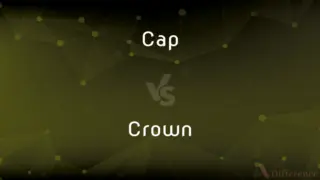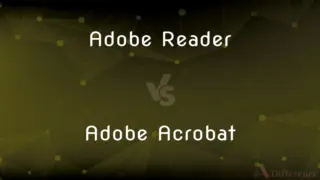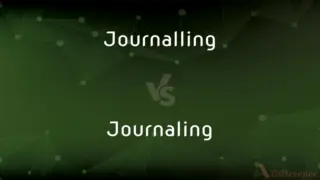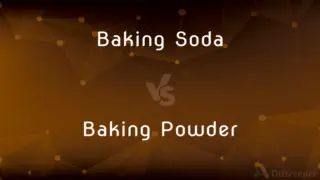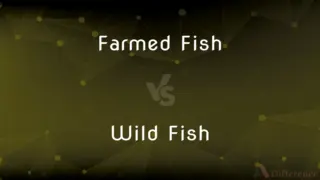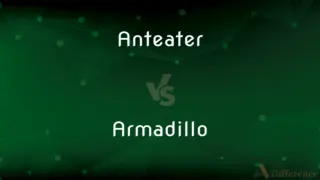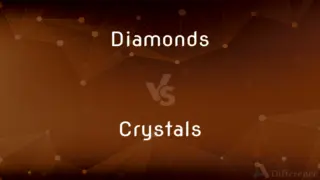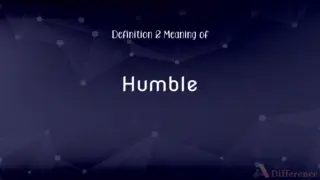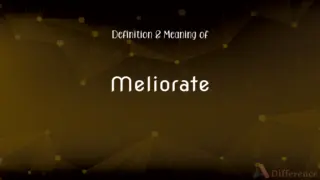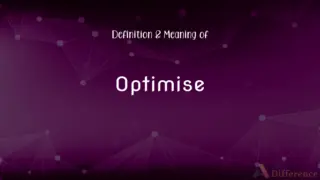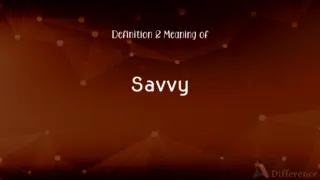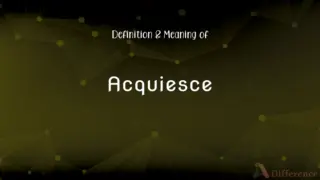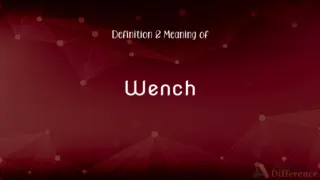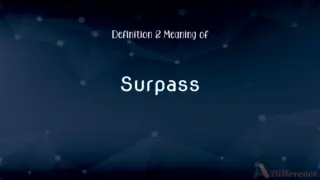Silica vs. Clay — What's the Difference?
By Tayyaba Rehman & Fiza Rafique — Updated on May 9, 2024
Silica, a hard mineral primarily composed of silicon dioxide, is key in making glass and ceramics; clay, a soft, earthy material rich in minerals, is essential for pottery and bricks.

Difference Between Silica and Clay
Table of Contents
ADVERTISEMENT
Key Differences
Silica, chemically known as silicon dioxide, naturally occurs in quartz and sand, making it a primary component in the manufacturing of glass and ceramics. Clay, on the other hand, consists of various minerals with a finer grain and plastic texture, primarily used in making pottery and building materials like bricks.
Silica has a high melting point around 1700°C, which makes it ideal for high-temperature applications such as glass-making and metallurgy. In contrast, clay can be molded and shaped at much lower temperatures, typically between 600°C and 1200°C, making it suitable for ceramics and earthenware.
The hardness of silica contributes to its applications in industrial abrasives and construction, whereas clay's malleability allows for artistic and detailed sculpting in pottery and ceramics.
Silica is generally inert and does not react with most chemicals, which is why it is used in the production of containers and other items that need to resist chemical attack. Clay, however, can be reactive with certain substances, making it useful in products like adsorbents and catalysts.
In terms of environmental impact, silica dust is a significant health hazard, leading to diseases like silicosis when inhaled. Clay, although less hazardous, can still pose risks primarily related to dust inhalation during processing.
ADVERTISEMENT
Comparison Chart
Composition
Primarily silicon dioxide
Various minerals, including kaolinite
Melting Point
High (about 1700°C)
Lower (600°C to 1200°C)
Hardness
Very hard, used in abrasives
Soft, malleable, used in pottery
Chemical Reactivity
Inert, resists chemical attack
Can be reactive, used in adsorbents
Usage
Glass-making, ceramics, abrasives
Pottery, bricks, catalysts
Compare with Definitions
Silica
Found in nature as sand or quartz.
Silica beaches are known for their sparkling white sand.
Clay
Soft, earthy material rich in minerals.
Clay is commonly used for making pottery.
Silica
Mineral consisting of silicon dioxide.
Quartz is a well-known form of silica.
Clay
Shrinks and hardens when fired.
Fired clay pots are much harder and water-resistant.
Silica
Used in industrial abrasives.
Silica particles are used in sandblasting.
Clay
Can be molded when wet.
Artists sculpt wet clay into various shapes.
Silica
Major component in glass making.
Silica sand is melted to create glass.
Clay
Used in adsorbents and catalysts.
Clay is used in the refining of vegetable oils.
Silica
Inhalation can cause health issues.
Prolonged exposure to silica dust can lead to silicosis.
Clay
Used to make bricks and tiles.
Clay bricks are a fundamental building material.
Silica
A white or colorless crystalline compound, SiO2, which in the form of quartz and certain other minerals is a chief component of the earth's crust. Silica sand is used in making a wide variety of materials, such as glass and concrete.
Clay
Clay is a type of fine-grained natural soil material containing clay minerals. Clays develop plasticity when wet, due to a molecular film of water surrounding the clay particles, but become hard, brittle and non–plastic upon drying or firing.
Silica
Silicon dioxide.
Clay
A stiff, sticky fine-grained earth that can be moulded when wet, and is dried and baked to make bricks, pottery, and ceramics
A clay soil
A clay tile
The soil is mainly clay
The rocks are covered by various mixtures of loose clays and sands
Silica
Any of the silica group of the silicate minerals.
Clay
A European moth with yellowish-brown wings.
Silica
Silicon dioxide, SiO . It constitutes ordinary quartz (also opal and tridymite), and is artifically prepared as a very fine, white, tasteless, inodorous powder.
Clay
A fine-grained, firm earthy material that is plastic when wet and hardens when heated, consisting primarily of hydrated silicates of aluminum and widely used in making bricks, tiles, and pottery.
Silica
A white or colorless vitreous insoluble solid (SiO2); various forms occur widely in the earth's crust as quartz or cristobalite or tridymite or lechartelierite
Clay
A hardening or nonhardening material having a consistency similar to clay and used for modeling.
Clay
(Geology) A sedimentary material with grains smaller than 0.002 millimeter in diameter.
Clay
Moist sticky earth; mud.
Clay
The human body as opposed to the spirit.
Clay
A mineral substance made up of small crystals of silica and alumina, that is ductile when moist; the material of pre-fired ceramics.
Clay
An earth material with ductile qualities.
Clay
(tennis) A tennis court surface made of crushed stone, brick, shale, or other unbound mineral aggregate.
The French Open is played on clay.
Clay
(biblical) The material of the human body.
Clay
(geology) A particle less than 3.9 microns in diameter, following the Wentworth scale.
Clay
A clay pipe for smoking tobacco.
Clay
A clay pigeon.
We went shooting clays at the weekend.
Clay
(informal) Land or territory of a country or other political region, especially when subject to territorial claims
Danzig is rightfully German clay.
Clay
(transitive) To add clay to, to spread clay onto.
Clay
To purify using clay.
Clay
A soft earth, which is plastic, or may be molded with the hands, consisting of hydrous silicate of aluminium. It is the result of the wearing down and decomposition, in part, of rocks containing aluminous minerals, as granite. Lime, magnesia, oxide of iron, and other ingredients, are often present as impurities.
Clay
Earth in general, as representing the elementary particles of the human body; hence, the human body as formed from such particles.
I also am formed out of the clay.
The earth is covered thick with other clay,Which her own clay shall cover.
Clay
To cover or manure with clay.
Clay
To clarify by filtering through clay, as sugar.
Clay
A very fine-grained soil that is plastic when moist but hard when fired
Clay
Water soaked soil; soft wet earth
Clay
United States general who commanded United States forces in Europe from 1945 to 1949 and who oversaw the Berlin airlift (1897-1978)
Clay
United States politician responsible for the Missouri Compromise between free and slave states (1777-1852)
Common Curiosities
How is clay different from silica in terms of texture?
Clay is softer and more malleable than silica, which is hard and brittle.
What are the health risks associated with silica?
Silica dust can cause lung diseases such as silicosis when inhaled.
Can silica be found in nature?
Yes, silica naturally occurs in forms like sand and quartz.
Is silica reactive with chemicals?
No, silica is inert and does not react with most chemicals.
What types of products are made from clay?
Products like pottery, bricks, tiles, and some catalysts are made from clay.
How does the environmental impact of silica compare to clay?
Both can impact the environment through mining, but silica dust is particularly hazardous to health.
What temperatures are required to process clay compared to silica?
Clay can be processed at temperatures between 600°C and 1200°C, much lower than silica which requires around 1700°C.
Why is clay preferred in pottery?
Its plasticity allows it to be easily molded and shaped, ideal for pottery.
What is silica primarily used for?
Silica is primarily used in the manufacturing of glass, ceramics, and as an abrasive.
What are the main minerals found in clay?
Clay typically contains minerals like kaolinite, montmorillonite, or illite.
Share Your Discovery

Previous Comparison
Wireless vs. Landline
Next Comparison
Flip vs. SomersaultAuthor Spotlight
Written by
Tayyaba RehmanTayyaba Rehman is a distinguished writer, currently serving as a primary contributor to askdifference.com. As a researcher in semantics and etymology, Tayyaba's passion for the complexity of languages and their distinctions has found a perfect home on the platform. Tayyaba delves into the intricacies of language, distinguishing between commonly confused words and phrases, thereby providing clarity for readers worldwide.
Co-written by
Fiza RafiqueFiza Rafique is a skilled content writer at AskDifference.com, where she meticulously refines and enhances written pieces. Drawing from her vast editorial expertise, Fiza ensures clarity, accuracy, and precision in every article. Passionate about language, she continually seeks to elevate the quality of content for readers worldwide.















